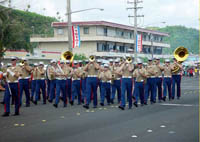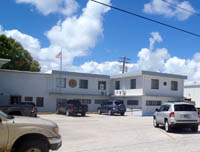American Legion Guam History
The American Legion Mid-Pacific Post 1, established on August 26 1930, is the oldest American Legion post in the Western Pacific. It is the only American Legion Post to have survived occupation by a foreign country when Guam was invaded and occupied by the Japanese during World War II. The native inhabitants of Guam and the Legion Post suffered greatly under the Japanese. Throughout U.S. history, the territory of Guam has given many sons and daughters to the Defense of the United States. The American Legion Mid-Pacific Post 1 Guam honors all US military veterans, active duty military and their families regardless of branch of service or when or where they served.
Guam was ceded by Spain to the United States in the Treaty of Paris ending the Spanish American War in 1898 ending 230 years of Spanish colonization. Except for the Japanese invasion and occupation, 1941 through 1944, Guam was governed by the US Navy administration until a civilian Guam Government was established by the U.S. Congress with the Organic Act of 1951. Today, Guam is a metropolitan community inhabited by native Chamorros, Filipinos, mainland U.S. transplants, Japanese, Chinese, Koreans, Australians and Europeans and a significant population of active duty U.S. Military and military veterans.
Very little Guam American Legion historical documentation or artifacts still exists or can be located. Most of the original Post documents were captured and destroyed or stolen as souvenirs by the Japanese occupiers during World War II. As a U.S. military veteran organization, the Post was forced underground and, it is believed, the Japanese Army likely discovered and destroyed Post records. The account of Post history presented here was compiled from the few surviving Post documents, newspaper articles, correspondence between Mid Pacific Post 1 and American Legion National Headquarters, to include applications for Post Charters.
The American Legion Guam Post is Born
Birth of Mid-Pacific Post 1 (1930). The American Legion Mid-Pacific Post 1 was born on August 26, 1930 when the Post was established with 17 charter members consisting of local veterans and active duty members of the U.S. Navy government of Guam1. The official charter was destroyed or lost during the Japanese occupation>: however, the application to establish the post lists J. A. McCormack as the Post Commander. An article in the September 1930 issue of the Guam recorder2 reports the first public function of Post 1, held on 28 August 1930 attended by numerous island dignitaries, including an address by the Territorial Governor, and lists the following officers:
| Commander: J.A. McCormac Vice Commander: H. W. Elliott Adjutant: Jose Rosario |
Finance Officer: F. T. Flores Historian: J. S. Aflague Sergeant at Arms: Otto Cox |
In a 13 November 1931 election of officers, the above incumbents were all re-elected as was a new Chaplain Rev. Francis Lee Albert and the Executive Committee at Large members Willis W. Bradley, Jr., Vicente Rosario and Daryl Wigle. In a letter of 26 January 19383, Commander M. Scambelluri reported to the American Legion National Commander election of the following officers:
| Commander: M. Scambelluri Senior Vice Commander: V. Rosario Junior Vice Commander: V. Munoz Chaplain: E. M. Garrido |
Adjutant: J. S. Aflague Finance Officer: V. Manglona Historian: P. Sanchez Sergeant at Arms: J. Perez |
The Guam Museum, 1932 through 1936. When a Guam Museum was established in the Plaza Espana in 1932, the American Legion Mid-Pac Post 1 volunteered to manage it. The original museum displayed a small donated collection of artifacts that formed the foundation of a Chamoru exhibit. The Legionnaires used their own funds to operate and manage the exhibits until 1936 when the Navy Government took over operations. The building was destroyed during the shelling of Hagatna during World War II.4
The American Legion Under Japanese Occupation
 Life Was Brutal
Life Was BrutalUnder the Japanese
The Japanese Occupation, December 1941 through August 1944. Just hours after the surprise attack on Pearl Harbor on December 7, 1941 (December 8th on Guam), the Japanese invaded Guam. The U.S. Naval Governor surrendered Guam to the Japanese on December 10th. The Japanese occupation was brutal on the local populace and membership in the Legion was exceptionally precarious. As noted in a 1945 article in the Indianapolis (Indiana) News5, every precaution was taken to hide membership. Known or suspected Legionnaires were under constant surveillance, often arrested and seven were accused of being spies and beheaded. The Japanese either destroyed, or kept for souvenirs Post records, flags, uniforms, caps and any other paraphernalia they could find which explains the lack of documentation of early Post history.
The Liberation of Guam
Liberation and Post Reactivation. During the early hours of July 21, 1944, the U.S. 77th Army Division, 3rd Marine Division and 1st Provisional Marine Division, landed at Asan, just South of present day Hagatna, and Agat, just South of present day Naval Station. Although the Japanese refused to surrender, the Americans regained control of Guam on August 10, 1944.A few holdouts remained hidden in the Guam jungles for years. Sergeant Yokoi Shoichi hid in the jungles of Guam near Talafofo and was not discovered until 24 January 1972. The liberation is one of the most prominent milestones in American Legion Guam history and Guam history. Today, July 21st, Guam Liberation Day, is a major public holiday complete with parades honoring veterans of this and other conflicts.
A 1945 article appearing in the Indianapolis News5 reported that Mid Pacific Post 1 was reactivated with 51 members and, for the first time, had a unit of the American Legion Auxiliary. The Post had over 100 members before the war. The following officers were installed:
| Commander: W.T. Raplee Adjutant: J. C. Cruz Treasurer: Ben Guerrero |
Historian: Pablo Sanchez Service Officer: Juan S. Aflague |
The Missing Years (1946 through 1982). Post records for the years 1946 through 1972 cannot be located. It is possible that the Post became inactive because the Charter was cancelled on 10 September 1961. Any information or documents that would reflect or help us fill in the Post history would be greatly appreciated. Contact the Post or speak to any officer at the Post.
Post Resurrection (1982). By 1982, two VFW Posts were thriving on Guam. Several veterans got together to explore the activation of a veterans organization for honorably discharged veterans who were not eligible to be members of the VFW. Most prominent among these veterans was Bobby Cobb who contacted the Department of Alaska and set the process in motion to reactivate the post as American Legion Post 53 under Department of Alaska, with 63 Charter Members and the following officers:
| Commander: Bobby Cobb First Vice Commander: Verne I. Harper Second Vice Commander: Glenn A. Harkless Adjutant: David R. Runyon Judge Advocate: Mitchell P. Golden |
Sergeant at Arms: Clyde P. Barnes Historian: Ercil D. Cook Public Relations Officer: Clyde A. Benge Chaplain: Frank C. Christensen |
Mid Pac Post 1 Today
 Post Entry Hall
Post Entry HallMid-Pacific Post 1 Today. In 1995 the Post requested and was granted authority to revert to its original designation as Mid-Pacific Post 1. Since re-activation as Mid Pacific Post 1, the Post has occupied several homes until purchasing and relocating to its current home in Tamuning in 1998. The Post is active in community services and conducts an awards program for JROTC units at four island high schools. It conducts an annual flag retirement ceremony on 14 June and participates in memorial activities in conjunction with other veterans organizations. The Post operates a canteen for members and guests and holds monthly membership meetings on the 1st Saturday of every month at 10:00AM at the Post home.
Reference
1. Application for American Legion Post, dated 17 July 1930.
2. Article “American Legion Mid-Pacific Post 1 Hold First Public Function:, The Guam Recorder, Vol VII, Number VI, September 1930, Pages 107, 118 and 119.
3. Letter, dated 26 January 1938, from M. Sgambelluri, Commander Mid-Pacific Post 1, to the National Commander, American Legion.
4. Article, Guampedia, https://www.guampedia.com/american-legion/
5. Article “Legion Post Reactivated by Plucky Guamese”, Indianapolis News, August 1945
6. Letter, dated May 31, 1945, from Enrique M. Garrido, Commander, Mid Pacific Post 1, to Henry M. Dudly, Assistant National Adjutant, American Legion Headquarters.
 U.S. Navy Government
U.S. Navy Government US Marines Landing
US Marines Landing Liberation Day Parade
Liberation Day Parade Post Home
Post Home